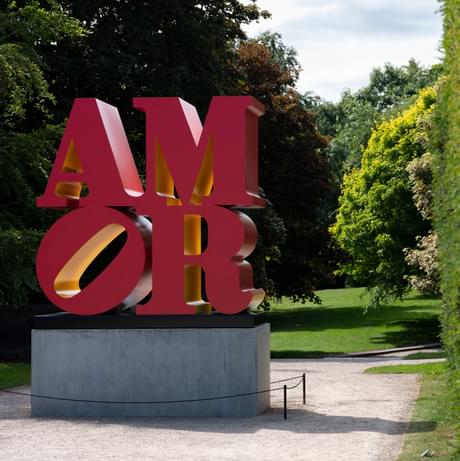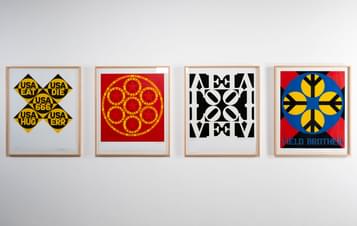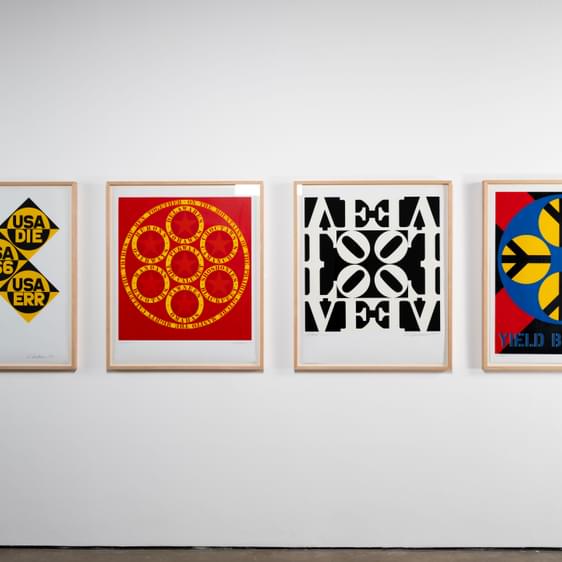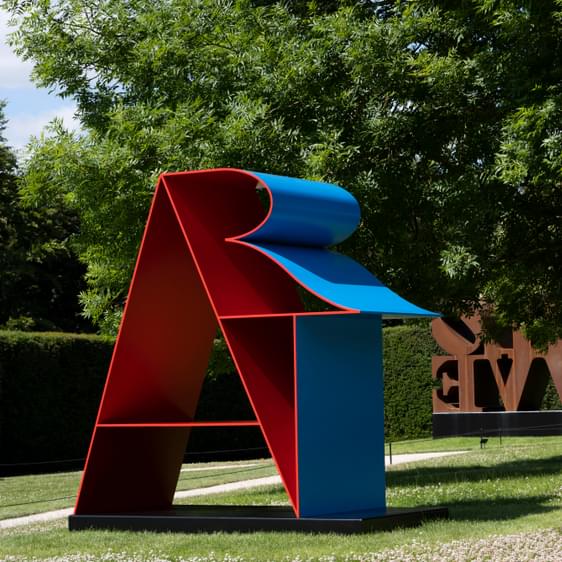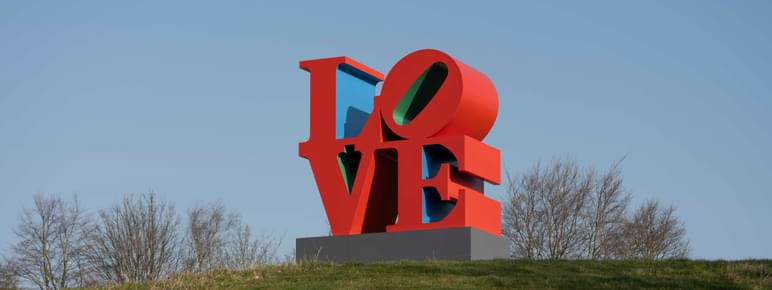
About Robert Indiana: Sculpture 1958-2018
YSP presented the first major European exhibition of sculpture, painting and prints by American artist Robert Indiana in 2022-23.
Robert Indiana: Sculpture 1958-2018 traced the development of sculpture across six decades. The exhibition explored the complex character of Indiana’s art practice and considered his view of the darker side of the American dream. This was a time of vast social and political change. Unity, acceptance and love are themes that run throughout Indiana’s work. These remain relevant today for movements against racism and discrimination towards LGBTQIA+ communities.
Indiana’s iconic LOVE (Red Blue Green) (1966–1998) welcomed visitors at the entrance to YSP. It is usually shown in an urban context, but here it was set within the Yorkshire countryside. The artist first used the word 'love' in a painting in 1961. In 1964 he began a series of LOVE paintings which used the slanted ‘O’ within a square format. Indiana said that this was “the most dynamic way to use four letters”. The sculpture of LOVE was first made in 1966, using aluminium. The LOVE sculptures still hold a close relation to the two-dimensional letters.
Indiana was an advocate for many human rights issues, and central to the exhibition were his important social justice works. Mississippi (1965), from the artist’s Confederacy series, was a controversial response to racist atrocities committed against the United States Civil Rights movement of the 1950s and ‘60s, harking back to the 1861-65 American Civil War, with its formation of the pro-slavery and white supremacist Confederate States. Love Rising (The Black and White Love) (1968) was made in the aftermath of the assassination of Dr. Martin Luther King Jr., and Ash (1985), from Indiana’s Vinalhaven Construction series, references the gay community’s response to the AIDS crisis of the 1980s.
Beginning with Indiana’s earliest relief and collage forms, which incorporate found objects and remnants of industry taken from derelict warehouses near to his studio, the exhibition unfolded across Indiana’s series of sculptures made for both indoors and outdoors. One of the earliest works in the exhibition, The Melville Triptych references Coenties Slip, the street in Manhattan where Indiana lived from 1956 amid a community of notable artists, including Ellsworth Kelly, Agnes Martin and Cy Twombly, before he moved in 1978 to Vinalhaven, an island off the coast of Maine. Although away from the New York art scene, Indiana continued to create works in his home and studio, Star of Hope, which is now under the supervision of a foundation he created to preserve his legacy and promote visual arts education.
Striking groups of Columns and Herms were displayed across three gallery spaces, including early wooden constructions as well as later bronze casts. Varying in size from just over 1 metre to 3.5 metres tall, these sculptures were created using salvaged materials from the demolished industrial buildings surrounding the artist’s studio. Indiana studied typography whilst he was a student at the University of Edinburgh and the use of words and numbers became central to his artistic practice, particularly the exploration of their physical form. He first used words on his early wooden Herms, with the choice of word being dictated in part by the space in which the artist intended it to fit. He sought to use words that summarised a theme or feeling in the most direct way, for example, ‘eat’ to represent ‘life’ and ‘die’ to represent ‘death’.
Indiana’s brilliantly coloured, 6-foot-high aluminium sculptures ONE Through ZERO (The Ten Numbers) (1980–2001) were displayed on the lawn outside the Underground Gallery. Blending painting and sculpture, the Numbers represent the stages of human life, from birth to death. Indiana’s fascination with numbers stemmed from an acute awareness of how they are connected to everything we do and how they are understood across many languages. “Numbers fill my life,” he stated. “They fill, my life even more than love. We are immersed in numbers from the moment we’re born.”
The exhibition is supported by Morgan Art Foundation Ltd. and the Henry Moore Foundation.
All works by Robert Indiana, installation view at Yorkshire Sculpture Park, 2022. Photos: © Jonty Wilde, courtesy of Yorkshire Sculpture Park. Artworks: © 2022 Morgan Art Foundation Ltd./ Artists Rights Society (ARS), New York/DACS, London
Free activities for families
Explore creative ideas to help you discover the Robert Indiana exhibition.
You might also like
More
Angela Harding: A Chronicle of Birds and Beasts
–Ten years after Angela Harding's first exhibition at YSP, we are thrilled to be welcoming her back in winter 2026.Annie Montgomerie: Missies and Nippers
–Following her sell-out show Hand Me Downs in 2022, Annie Montgomerie will be back next summer with a new exhibition Missies and Nippers.Andi Walker: Wrapped in Cold Hard Comfort
Spring 2026Leeds-based artist Andi Walker presents Wrapped in Cold Hard Comfort, a new outdoor sculpture to be revealed in spring 2026.- Event
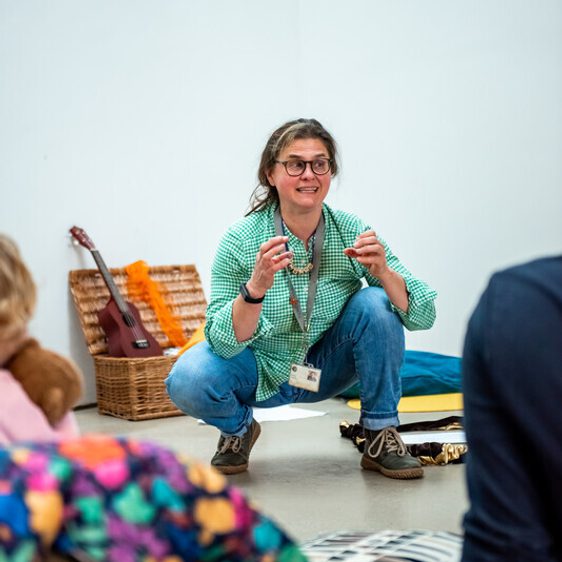
Storytelling in the Gallery: William Kentridge
–Led by our spellbinding storytellers, move, make and imagine together, inspired by the William Kentridge: The Pull of Gravity exhibition.
